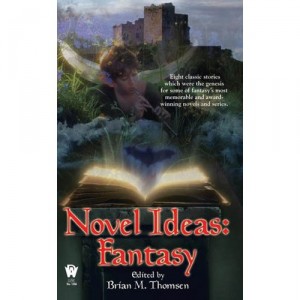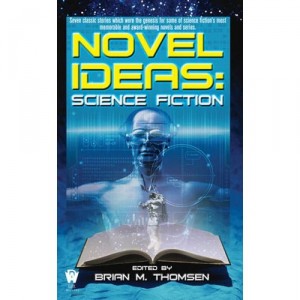 These two books are best looked at as a pair, since they look at the two sides of the same coin. Every so often, it seems, a story or novella comes along which is just so good, so powerful, or so brimming with potential that it deserves to be expanded into something greater. Thus, an award-winning story becomes the seed for a full novel, or even an entire series. Brian Thomsen’s collected some of these early masterworks and, in all cases but one, he has gotten the authors to contribute commentary on how each one of these stories evolved later on. (The Gordon Dickson story is accompanied by an introduction by the editor.)
These two books are best looked at as a pair, since they look at the two sides of the same coin. Every so often, it seems, a story or novella comes along which is just so good, so powerful, or so brimming with potential that it deserves to be expanded into something greater. Thus, an award-winning story becomes the seed for a full novel, or even an entire series. Brian Thomsen’s collected some of these early masterworks and, in all cases but one, he has gotten the authors to contribute commentary on how each one of these stories evolved later on. (The Gordon Dickson story is accompanied by an introduction by the editor.)
In the Fantasy volume, we thus run into Gordon R. Dickson’s “St. Dragon and the George,” Suzy McKee Charnas’ “Unicorn Tapestry,” Katherine Kurtz’s “The Gargoyle’s Shadow,” Lynn Abbey’s “Jerlayne,” Robert Silverberg’s “Gilgamesh in the Outback,” James Ward’s “Midshipwizard,” and two stories by Orson Scott Card, “Lost Boys” and “Hatrack River.”
The Science Fiction volume reprints Connie Willis’ “Fire Watch.” John Varley’s “Air Raid,” Anne McCaffrey’s “Lady in the Tower,” David Brin’s “The Postman,” Greg Bear’s “Blood Music,” Nancy Kress’ “Beggars in Spain,” and another Orson Scott Card story, “Ender’s Game.”
 Now, I must confess that I haven’t read a lot of the novels derived from these stories, so I can’t accurately compare the beginning product to the finished one in all cases. But when looking at something like “Midshipwizard” as it relates to the novel Midshipwizard Halcyon Blithe, or the story “Ender’s Game” versus the book, it’s fascinating to see how the authors kept the seeds of an idea even as they expanded the framework around it. In most cases, I’d even argue that the story is better for the added detail, background, character development and even plot. In some of these cases, such as Brin’s “The Postman,” McKee’s “Unicorn Tapestry,” or Varley’s “Air Raid,” I’m now inspired to go and find the later product, as the stories offered here really do feel like the beginning of something greater. Like many, my previous exposure to Brin’s story came through the Kevin Costner movie, and here I can see that the movie didn’t do the original work justice. So whether you’ve read the original short story, the novel it became, both, or neither, these two books offer up some interesting material. I did have to wonder at the inclusion of three Card stories, as that seems disproportionately heavy given the relatively low number of authors represented in the first place. Obviously, there are plenty of stories out there which could also have been featured. Enough for a second round of volumes, should these catch on, I might hope.
Now, I must confess that I haven’t read a lot of the novels derived from these stories, so I can’t accurately compare the beginning product to the finished one in all cases. But when looking at something like “Midshipwizard” as it relates to the novel Midshipwizard Halcyon Blithe, or the story “Ender’s Game” versus the book, it’s fascinating to see how the authors kept the seeds of an idea even as they expanded the framework around it. In most cases, I’d even argue that the story is better for the added detail, background, character development and even plot. In some of these cases, such as Brin’s “The Postman,” McKee’s “Unicorn Tapestry,” or Varley’s “Air Raid,” I’m now inspired to go and find the later product, as the stories offered here really do feel like the beginning of something greater. Like many, my previous exposure to Brin’s story came through the Kevin Costner movie, and here I can see that the movie didn’t do the original work justice. So whether you’ve read the original short story, the novel it became, both, or neither, these two books offer up some interesting material. I did have to wonder at the inclusion of three Card stories, as that seems disproportionately heavy given the relatively low number of authors represented in the first place. Obviously, there are plenty of stories out there which could also have been featured. Enough for a second round of volumes, should these catch on, I might hope.
In general, I found this set of anthologies to be both fascinating and useful, a worthy introduction to some science fiction and fantasy works I’d either missed out on previously, or never really looked at for one reason or another. As soon as I can make some space on my shelf, you can bet I’ll be looking to read a few classics as a result.
Originally posted on SF Site, 2006
